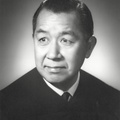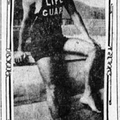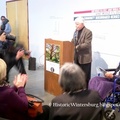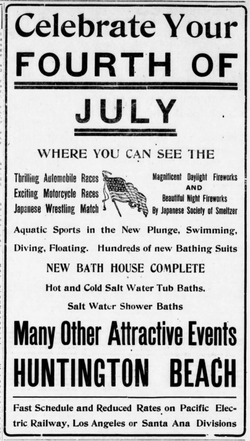
The first fireworks in Huntington Beach were brought by the Smeltzer Japanese Association in 19051, as their contribution to the patriotic celebration. By 1910, the daylight and evening fireworks were an advertised highlight of the Huntington Beach July 4th events, beginning in the morning and continuing through nightfall.
In 1910, the saltwater plunge near the Huntington Beach pier was open and the Pacific Electric Railway line along the beach dropped visitors off next to the pier by the hundreds.
Thousands were making their way to Southern California beaches for the holiday. The Los Angeles Herald reported on July 4, 1910, that the Pacific Electric Railway had the biggest day its company had known, with a reported 30,000 heading to Long Beach and thousands more to Newport Beach, Balboa Beach, and Huntington Beach.
Ten days after the Independence Day holiday in 1910, hundreds more would arrive for the Methodist “tent city” at Huntington Beach with a reported 300 canvas tents going up near 11th Street for a July 14 opening. Six years after Henry Huntington brought the Pacific Electric Railway to town in 1904, the township and nearby Wintersburg Village were bustling.
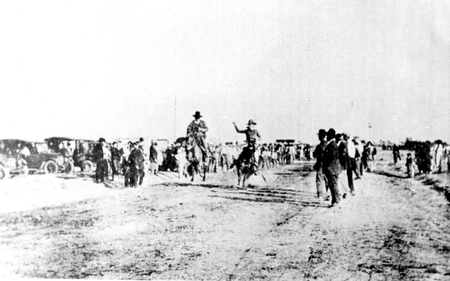
A “committee of enterprising citizens” organized the 1910 July 4 holiday and received an offer by the Wintersburg Japanese Association (Smeltzer) to again provide the fireworks for Independence Day at no cost to the community and at an estimated value of $200, an equivalent of over $5,000 in 2018.
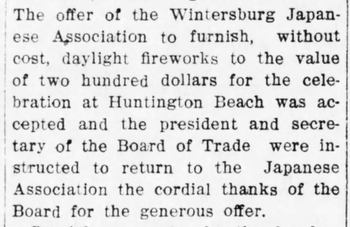
The committee proudly reported “the Fourth of July will be celebrated in Huntington Beach this year in a ‘safe and sane’ way, yet in a manner that will afford amusement and entertainment to a large number of visitors who annually seek here the delightfully cool climate and refreshing ocean breezes which make this city so desirable as a summer resort.” The committee planned automobile and motorcycle races, fireworks provided by the Japanese Association, “and the usual smaller attractions.” They secured special railroad car service to Huntington Beach from the Pacific Electric Railway, anticipating a large crowd.

The day’s events would start with the “customary Independence Day oration” by Los Angeles attorney W. H. Anderson. The Santa Ana Register advised his speech “will occupy only about 20 minutes” before the livelier activities began and encouraged everyone to arrive on time.
Crowds gathered for horse races along the beach from 10:30 am to 12:30 pm, foot race competitions at the baseball grounds for girls and boys, and a “free-for-all dash around the bases at baseball ground” followed by daylight fireworks at 1 pm (which continued through evening). In the middle of the afternoon on July 4, 1910, the City of Orange baseball team took on the home team at the baseball field in the downtown. But, before the baseball game the committee planned a greased pig race for which “an especially swift porker has been secured for the occasion and the supply of grease is large.”
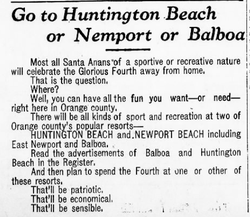
As night fell and fireworks lit up the sky, the Huntington Beach concert band—which had played throughout the day—provided live music for a dance near the beach. Music of the day might have included “Let me Call You Sweetheart,” “Come Josephine in My Flying Machine,” and the still-popular “Chicken Reel.” This also was the year that “America the Beautiful”—an 1895 poem originally titled “Pike’s Peak” and written by Katharine Lee Bates—was first published with the music by which we know it today.
The Santa Ana Register reported on July 5, 1910, that “horse racing and day fireworks at Huntington Beach drew a large crowd. Huntington was the most bravely decorated in flags and bunting of any of the beach places, and many jolly picnic parties were in evidence.”
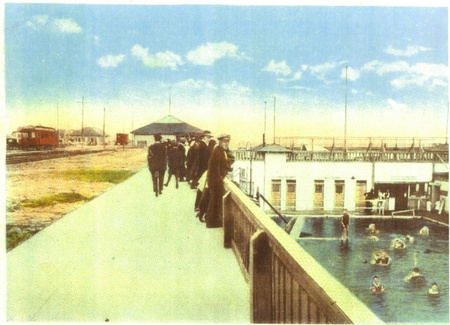
Note:
1. Hansen, Debra Gold; Ryan, Mary P.; “Public Ceremony in a Private Culture: Orange County Celebrates the Fourth of July,” University of California Press, 1991.
*This article was originally published on Historic Wintersburg blog on July 2, 2018.
© 2018 Mary Urashima


